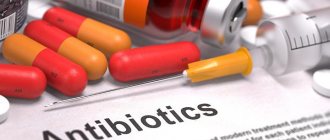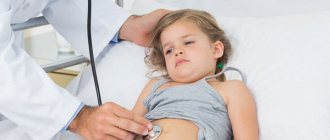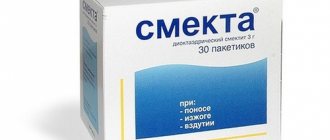About 70 serotypes of viruses are located in the human intestine. Each of them can become a causative agent of infection. Every person has been infected at least once. All processes that are launched subsequent to infection negatively affect the functioning of the gastrointestinal tract. The occurrence of infection is associated with the presence of bacteria, viruses or toxins in the patient’s body.
- 4.1 Protozoans
What is an intestinal infection?
Intestinal infection is an acute viral disease. Groups of infectious diseases are classified according to the causative agent, causes and symptoms of the disease. The development of the disease occurs due to the invasion of pathogenic microorganisms. After infection, it takes from 10 hours to 2 days until the first symptoms appear. The main symptoms disappear after 5-6 days, absolute recovery occurs after 3 weeks. Infections in the intestines can be viral and bacterial. Dysentery, salmonellosis, staphylococcus and their types cause the greatest damage to health. The hot season for intestinal infections is summer. Acute infectious diseases are transmitted mainly through the fecal-oral route.
Reviews
The most effective and safe drug for the treatment of intestinal infections is Norfloxacin (Normax) and Levofloxacin. They can also be used to treat traveler's diarrhea, cystitis, urethritis, pyelonephritis, salmonellosis, shigellosis, etc. However, Norfloxacin is not prescribed to children, nursing and pregnant women. It should be taken with caution by epileptics, people with atherosclerotic disease and gastric ulcers.
Many women use Enterofuril to treat their children. It is also prescribed by most pediatricians when an intestinal infection is suspected. This medicine meets all safety requirements and quickly brings relief to the child, relieving the severity of symptoms such as vomiting and diarrhea.
Bacterial infections and their symptoms
Staphylococci produce toxins that disrupt cell functioning.
Bacteria in the gastrointestinal tract become infectious agents. The course of a bacterial infection is more severe than a viral one. An acute bacterial illness can be accurately diagnosed by checking the intestines in a clinic. There are these types of bacteria:
- staphylococcus;
- coli;
- shigella;
- Vibrio cholerae;
- salmonella and others.
When bacteria enter the body through food, they immediately begin to multiply and release toxins. It is precisely the rate of reproduction in the gastrointestinal tract that makes them dangerous. Bacterial infections are characterized by the fact that the infected person experiences diarrhea with a daily volume of feces of more than 1 liter, bloody or watery stools. Human damage occurs:
- through contact with carriers of the disease;
- in case of non-compliance with personal hygiene rules;
- when drinking untreated water,
- food products.
Salmonellosis
Salmonella provokes acute intestinal infections.
The Salmonella genus includes 1,700 serotypes. Poultry is the main carrier of the bacterium. Most often they become infected when the shell of a bird's egg is not properly cleaned. With rare contamination of products, the incidence rate is relatively low. In the human stomach, salmonella produce toxins that cause diarrhea. Salmonella grows into the mucous membrane (infiltration occurs, but not lymphocytic), and inflammation subsequently appears.
Staphylococcus
The bacterium is the leader in causing vomiting and stomach upset. You can become infected with an intestinal infection through food. Even at room temperature, bacteria produce toxic substances in foods. The greatest threat is posed by fermented milk products, confectionery and salads with dressings. Symptoms go away within 24 hours. Signs of staphylococcus:
- violent diarrhea;
- abdominal pain.
Typhoid fever
Salmonella is considered the causative agent of acute typhoid fever. The infected person becomes the carrier of the infection. Typhoid fever has a chronic form of the disease; it manifests itself with periodic relapses. Salmonella can only be destroyed by exposure to high temperatures or chemicals. Signs:
- chills;
- weakness;
- headache;
- grayish-white coating on the tongue;
- diarrhea or constipation. Relief in the patient's condition is observed after 7 days.
Klebsiella
The presence of Klebsiella in the body can cause a temperature increase of up to 40 degrees.
The rod-shaped microorganism Klebsiella belongs to the normal microflora in the intestine. Klebsiella affects the gastrointestinal tract, mucous membranes of the eyelids and joints. The bacteria have been proven to be resistant to temperature differences, ultraviolet radiation and chemicals. It is easy to catch it in medical institutions or through food. When a person is poisoned, the release of toxins and the development of inflammation begins. The bacteria appears:
- acute abdominal pain;
- high temperature, up to 40 degrees;
- loose stool.
Colibacillosis
Colibacillosis is caused by Escherichia coli Coli. Infectious contamination can occur everywhere. In a one-time case, they are engaged in identifying the source, conducting a laboratory examination of the environment of the infected person, and taking measures that prevent the dispersion of the source of the disease. After poisoning, your stomach hurts and you feel weak and have a high fever. Symptoms are standard for a bacterial infection. The patient's condition begins to improve within two weeks. Do you want to make good use of your free time? You can register at an online casino and choose slot machines with instant withdrawal of money. This is a great way to plunge into the atmosphere of excitement and get an increase in your wallet. Moreover, the choice is huge and everyone can choose a slot “according to their interests.”
Suppositories for dysbacteriosis
Drug treatment of dysbiosis is carried out not only with drugs in the form of capsules and tablets, but also in the form of suppositories, which differ in composition (antibiotics, probiotics) and method of use (vaginal, rectal). The advantages of this dosage form of the drug include local effects, which allows you to normalize the microflora locally without affecting the entire body as a whole.
Vaginal
Vaginal suppositories are used to treat bacterial vaginosis in women and restore normal vaginal microflora.
Polizhinaks, Terzhinan, Betadine - antibacterial suppositories inhibit the development of pathogenic microorganisms (bacteria and fungi), prevent trichomoniasis and other infections. Contraindication for use is pregnancy, especially in later stages.
Labilakt, Acylakt, Vagilakt, Gynoflor - suppositories with a probiotic complex, which consists of lactobacilli, bifidobacteria, as well as estriol, lactose and other ingredients. These drugs restore normal vaginal microflora after treatment with antibiotics, with excessive proliferation of pathogenic microorganisms due to hormonal imbalance, with weakened immunity, diabetes and thrush.
Rectal
Rectal suppositories restore normal intestinal microflora in adults and children; there are two groups of agents - antibacterial and probiotic.
Apis, Kipferon, Prostopin, Anuzol, Nilegan, Genferon, Levomycetin, Procto, Viferon - antibacterial, antimycotic rectal suppositories contain local antibiotics, antiviral and antifungal agents; they may contain glucocorticosteroids, which prevents inflammation of the intestinal walls. The local method of using suppositories eliminates side effects, while maintaining maximum effectiveness of the product for dysbacteriosis of any complexity. However, rectal antibacterial suppositories cannot be used during pregnancy.
Bifinorm, Laktonorm, Lactobacterin, Bifidumbacterin are suppositories with a probiotic complex that supply the intestines with beneficial microorganisms, restoring its normal microflora. The use of probiotics in the form of suppositories is more effective than in the form of tablets or capsules, since lacto- and bifidobacteria are not destroyed during the passage of the gastrointestinal tract, but are immediately delivered to their usual habitat.
Viral infections and symptoms
With a viral infection of the intestines, enlarged lymph nodes are observed.
The course of the disease can be mild or severe. It depends on the type of microorganism and the level of immune defense. Treatment in adults is much easier than in infants and older children. The causative agents of viral intestinal infections are:
- rotaviruses;
- adenoviruses;
- enteroviruses.
Varieties of viruses are transmitted through the fecal-oral or airborne routes. The diagnosis of viral intestinal infection is made in the following cases:
- pain in the abdominal cavity;
- high temperature;
- dehydration;
- respiratory infections;
- drowsiness;
- indigestion;
- enlarged lymph nodes;
- convulsions.
Other types
Protozoans
Giardiasis is the most common parasitic infection.
A single-celled virus belonging to the genus Protozoa is the causative agent of protozoan infection. The genus of protozoa causes giardiasis and amoebiasis. A person transmits microorganisms of this kind through contact with products. On food, Giardia cysts persist for a month at a temperature not exceeding 20 degrees. Once infected, symptoms may not appear for up to 6 weeks.
Fungal
The cause of the fungal infection, Candida, lives in the intestines and is harmless to health. But when yeast bacteria appear, they can spread, disrupting the microflora. For fungal infections, antibiotics and probiotics are prescribed. Symptoms of fungal colonization of the gastrointestinal tract:
- changes in stool character;
- diarrhea;
- flatulence;
- weakness;
- metallic taste in the mouth;
- an inexplicable desire to eat sweets.
List of probiotics
Drugs that restore the intestines after antibiotics represent a fairly large group of drugs. Below is a list of the most effective probiotics, according to reviews from doctors and patients:
Perhaps the most popular medicine from the category of multicomponent probiotics. Almost everyone hears it thanks to mass television advertising. Linex capsules contain bifidobacteria, lactobacilli and strains of enterococci. It is prescribed to both adults and children, as the drug is safe and has no contraindications. Linex is not prescribed only for the treatment of patients suffering from lactose intolerance.
Prescribed to eliminate manifestations of dysbiosis and digestive disorders of various etiologies, including when taking antibiotics to restore intestinal microflora. The drug is available in the form of capsules that are resistant to stomach acid. The capsules contain acidophilic lactobacilli and strains of kefir fungus, which acts as a prebiotic. When colonized in the intestines, beneficial bacteria eliminate the symptoms of dysbiosis, indigestion, intestinal infections and food allergies.
The drug is prescribed to restore microbiocenosis when antibiotics are prescribed to treat the intestines or other infectious diseases. The medicine is available in the form of drops and eliminates various disorders of the digestive tract (diarrhea, constipation, flatulence, nausea and others). The probiotic can be pre-diluted with tea, orange juice or water, but cannot be combined with milk and dairy products.
As an active component, it contains lyophilized cells that inhibit pathogenic microorganisms and eliminate the symptoms of diarrhea. The medicine can be taken even by the youngest patients from the moment of birth.
Probiotics are available in different dosage forms. These may be capsules, tablets, powders, drops or syrups. The doctor selects the optimal form of the drug to take individually, taking into account the patient’s condition and age. In addition, each popular drug has a lot of analogues. For example, instead of Linex, a doctor may prescribe:
- Bifidumbacterin;
- Lactobacterin;
- Laktomun;
- Biolact;
- Biosporin;
- Bificol;
- Lactiale;
- Normobakt.
Atsipol also has a number of analogues:
The choice of such a seemingly harmless drug as a probiotic must be agreed with your doctor. Only a specialist can tell you the best option for the drug needed when taking a particular antibiotic.
Diagnostic methods
The analysis result can be obtained within 10 minutes.
During the medical history, the doctor asks questions about the patient’s condition, diet, lifestyle and the possibility of his contact with carriers of the disease. Finds out whether chronic diseases are present. Symptoms play a role in the final verdict. If you are unsure of the diagnosis, additional consultation with one or more doctors is necessary. But it is advisable to diagnose a person only after receiving the examination results. Basic tests for a possible diagnosis of intestinal infection:
- Analysis of stool for the presence of rotavirus infection. The advantage is the speed of obtaining results - less than 10 minutes.
- Bacteriological culture examination. The result appears after 3-5 days.
- Polymerase chain reaction (PCR) of biological fluids. The result is obtained within a day.
- The enzyme immunoassay requires the patient's blood. The examination should be done approximately two weeks after infection to obtain data on the formed antibodies.
- During irrigoscopy, colonoscopy, and sigmoidoscopy, information about the patient’s intestinal microflora is obtained.
Causes of intestinal inflammation
The following factors can provoke the disease:
- infection by parasites, the violation is especially pronounced in the presence of a mixed type of helminthiasis;
- infectious lesion, which can also be caused by Trichomonas;
- autoimmune diseases, during which the body mistakes its own cells for foreign ones and begins to destroy them;
- genetic predisposition, most often manifested against the background of a lack of certain enzymes for digestion;
- errors in nutrition, especially with a passion for fatty, spicy and poorly fried foods;
- disturbances in the blood supply to the intestines, which can be caused by oncological processes and diseases of the cardiovascular system;
- disruption of intestinal microflora due to medications or other provoking factors;
- development of enteritis, manifests itself only in one area or throughout the entire section of the small intestine;
- the appearance of duodenitis, an inflammatory process in the duodenum and small part of the digestive tract;
- mesadenitis, an inflammatory process affecting the intestinal lymphatic system;
- colitis associated with the formation of a focus of inflammation in the colon.
Intestinal inflammation from the inside
Prescribed treatment
The type of drug therapy depends on the source of the disease.
Therapy is carried out both at home and in a hospital. For adults, to treat the infection, medications are primarily prescribed that are aimed at rehydration. They can be in the form of droppers, powder or tablets. Enterosorbents are prescribed; such drugs remove toxins. For example, “White Coal” or “Enterosgel”. The course of treatment includes enzymes in the form of “Mezim” or “Creon”. Features of the treatment of children with intestinal ailments are frequent hospitalization and the prescription of medications with minimal side effects.
Pregnant women are first prescribed absorbent drugs, and water-salt solutions are used as rehydration medicine. To maintain the body, a complex intake of vitamins is always prescribed. Diet is mandatory for accelerated recovery. You can begin to treat the infection and take medications only after consultation with an infectious disease doctor.
Antibiotics for children
- Amoxicillin tablets 500 mg 2 times a day.
- Meropenem 10–40 mg per 1 kilogram of child’s body weight per day intravenously or intramuscularly.
- Cefamezine 10–20 mg per 1 kilogram of child’s body weight per day intravenously or intramuscularly.
- Ceftriaxone 20–80 mg per 1 kilogram of child’s body weight per day intravenously or intramuscularly.
- Cefepime 50 mg per 1 kilogram of child’s body weight per day intravenously or intramuscularly.
- Aztreonam 50 mg per 1 kilogram of child’s body weight per day intravenously or intramuscularly.
- Azithromycin tablets 0.125 - 0.25 g 1 time per day.
- Clarithromycin tablets 0.25 g 2 times a day.
- Gentamicin 5 mg per 1 kilogram of child’s body weight per day intravenously or intramuscularly. This antibacterial drug is prescribed to children only for strict medical indications.
- Amikacin 5 mg per 1 kilogram of child’s body weight per day intravenously or intramuscularly.
- Nifuroxazide suspension 220–660 mg (1–3 scoops) 2–4 times a day.
- Levofloxacin tablets 0.25 g 2 times a day, intravenous drip 250 mg 1 time a day.
- Vancomycin 50 mg per 1 kilogram of child’s body weight intravenously 2 times a day.
- Metronidazole tablets 0.125 - 0.25 g 2 times a day.
The frequency of administration, dose of the drug and duration of treatment are determined individually by your attending physician.
Nutritional features and prevention
With a mild course of the disease, leave the usual foods and dishes, but reduce the number of calories consumed by a third. It is advisable to include dried toast bread and cereals in your diet. The diet involves the main method of heat treatment - steaming. In case of a more complex course, exclude from the diet:
- fatty dairy products;
- baking;
- confectionery;
- starchy vegetables;
- broth-based soups.
To protect against infection, you must follow the rules of personal hygiene and be careful about your diet. Products must be clean and fresh. It is preferable to choose mineral water for drinking rather than tap water. In the summer, it is advisable to limit the consumption of fatty, creamy foods. It is worth regularly doing wet cleaning of the premises. If there are children in the house, you need to disinfect things they come into contact with.
Is it wise to use medications?
Medication is the only reasonable option when colon inflammation occurs. If colitis progresses, it can lead to intestinal ischemia, diverticulosis, peritonitis and microcolitis.
One could rely on folk remedies, but these are only half-measures that will not bring quick results, if they can help with anything at all. Followers of folk remedies say that infusions and herbs are gentle on the intestines, but the same result can be achieved by using drugs and probiotics together. Only medications can cope with the situation, since there is no need for surgery.











